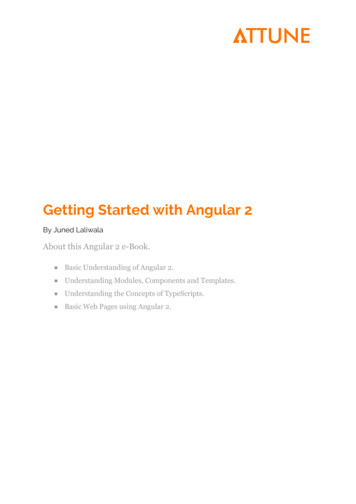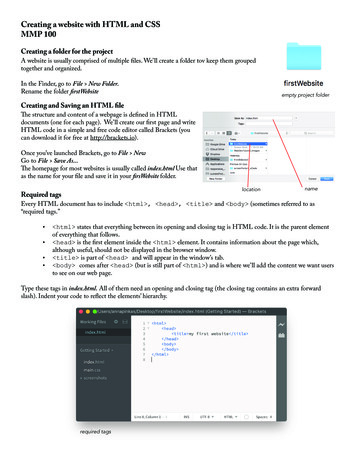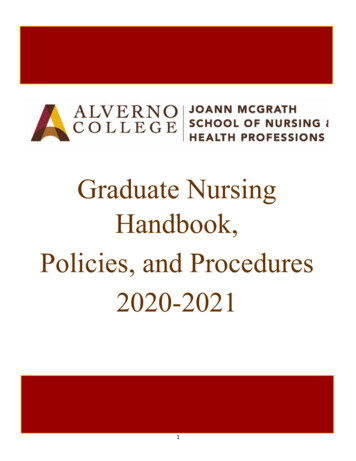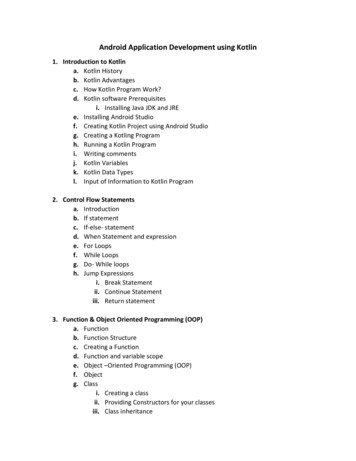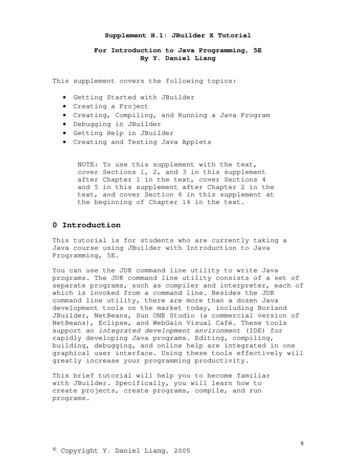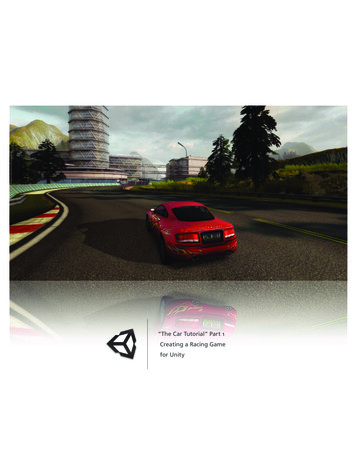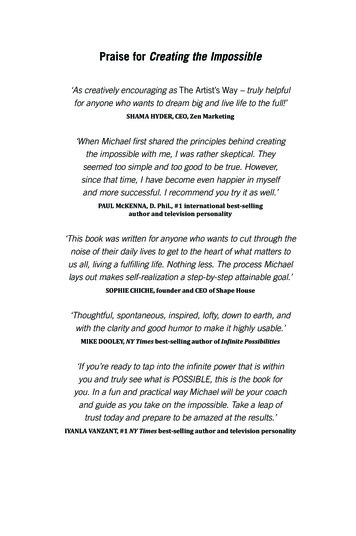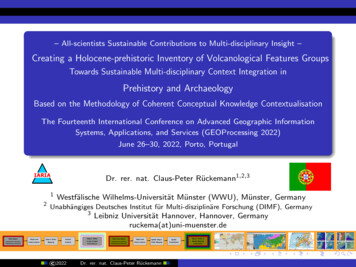
Transcription
– All-scientists Sustainable Contributions to Multi-disciplinary Insight –Creating a Holocene-prehistoric Inventory of Volcanological Features GroupsTowards Sustainable Multi-disciplinary Context Integration inPrehistory and ArchaeologyBased on the Methodology of Coherent Conceptual Knowledge ContextualisationThe Fourteenth International Conference on Advanced Geographic InformationSystems, Applications, and Services (GEOProcessing 2022)June 26–30, 2022, Porto, PortugalDr. rer. nat. Claus-Peter Rückemann1,2,312Westfälische Wilhelms-Universität Münster (WWU), Münster, GermanyUnabhängiges Deutsches Institut für Multi-disziplinäre Forschung (DIMF), Germany3Plain ObjectObject andObject / EntityContextunstructured or structured,Entity AnalysisMappingCreationunreferenced or referenced,. 2022Leibniz Universität Hannover, Hannover, 11111111111111111Object / 00000000000000111111111111111111in new 111111111111111111111111Plain Text ObjectObject andSpatial Object /Spatialunstructured or structured,Entity AnalysisEntity MappingVisualisationunreferenced or referenced,.Dr. rer. nat. Claus-Peter t / Entity 0000000000111111111111111111Spatial 11111111111000000000000000000111111111111111111and 11111111111111111111111
Epitome / AbstractEpitome / AbstractEpitome / abstractThis paper presents research on a practical solution for geoscientific inventoriesbased on conceptual contextualisation.The goal of this research is the creation of a practical Holocene-prehistoricinventory of worldwide volcanological features groups, integratingmulti-disciplinary coherent conceptual knowledge.The focus is a sustainable multi-disciplinary integration of knowledge contexts,especially from prehistory and archaeology, which further enables coherentconceptual knowledge contextualisation and georeferenced symbolicrepresentation.This paper provides implementations and realisations of the coherent conceptualknowledge and the methodological component integration. The resultinginventory is illustrated by excerpts of two features groups based on a conceptualknowledge result matrix.Future research will address the resulting Holocene-prehistoric inventory ofworldwide volcanological features, continuous development of resources andintegration and coherent conceptual knowledge contextualisation withprehistorical and archaeological knowledge resources. 2022Dr. rer. nat. Claus-Peter Rückemann
Common Information – The AuthorCommon Information – The AuthorInformation: CV, lectures, studies, materials, research, and networkingCurriculum /Publications, lectures, and rodi/en/#CoursesCongresses and searchDr. Claus-Peter RückemannWestfälische Wilhelms-Universität Münster (WWU)E-Mail: ruckema(at)uni-muenster.deChair of the Board of Trustees, Unabhängiges Deutsches Institut für Multi-disziplinäre Forschung (uDIMF);Chair of the Board on Advanced Computing and Emerging Technologies andChair of the Symposia Board, International Academy, Research, and Industry Association;General Chair and Chair of the Steering Committee ofThe International Conference on Advanced Communications and Computation (INFOCOMP);General Chair and Chair of the Steering Committee ofThe International Conference on Advanced Geographic Information Systems, Applications, and Services (GEOProcessing);Chair of the International Symposium on Advanced Computation and Information in Natural and Applied Sciences;Director GEXI Consortium; Head of research LX Foundation; Senior Member of Knowledge in Motion long-term project;Fellow Member of the Int. HPC and Artificial Intelligence Advisory Council; Member of the Indexing Committee Board, IARIA;Westfälische Wilhelms-Universität Münster (WWU);Senior Scientist and Senior Lecturer Information Science, Security, and Computing at Leibniz Univ. Hannover; IARIA Fellow. 2022Dr. rer. nat. Claus-Peter Rückemann
IntroductionIntroductionIntroductionThe goal of this research is the creation of a practical Holocene-prehistoricinventory of worldwide volcanological features groups, integrating arbitrarycoherent conceptual knowledge. The target is a sustainable multi-disciplinaryintegration of knowledge contexts, especially from prehistory and archaeology,which further enables a coherent conceptual knowledge contextualisation andgeoreferenced symbolic representation.The approach conforms with information science fundaments and universalknowledge, which enable an integration of the required components frommethodologies to realisations for knowledge representations of realia and abstractcontexts [1], considering that many facets of knowledge, including prehistory,need to be continuously acquired and reviewed [2].Creating contextualisation requires to integrate multi-disciplinary knowledge andto enable symbolic representations, e.g., integrating chorological andchronological contexts. Realisations need to integrate a wide range ofcomponents as required from participating disciplines, e.g., for dynamicalprocessing, geoprocessing, spatial contextualisation.Implementation and realisation based on the methodology of coherent conceptualknowledge contextualisation requires the integration of standardised, modularcomponents required for task within participating disciplines. 2022Dr. rer. nat. Claus-Peter Rückemann
IntroductionIntroductionIntroductionThis research employs knowledge resources, data sources, and Points of Interest(PoI), especially Knowledge Resources (KR) focussing on volcanological features,prehistory, and archaeology. Therefore, two major reference implementations weredeployed for implementation, realisation, and continuous further development.The coherent knowledge resources and the practical realisation are fully based onthe main implementations of the prehistory-protohistory and archaeologyConceptual Knowledge Reference Implementation (CKRI) [3] and theComponent Reference Implementations (CRI) framework [4]. CKRI provides theknowledge framework, including multi-disciplinary contexts of natural sciencesand humanities [5]. CRI provides the required component groups and componentsfor the implementation and realisation of all the procedural modules.The component and workflow procedure related research for this inventory is infocus of multi-disciplinary research groups and matter to be reported in separatepublications. Many aspects of knowledge, including meaning, can be describedusing knowledge complements supporting a modern definition of knowledge andsubsequent component instrumentation [6] [7], e.g., considering factual,conceptual, procedural, metacognitive, and structural knowledge. 2022Dr. rer. nat. Claus-Peter Rückemann
IntroductionIntroductionIntroductionKnowledge complements are a means of understanding and targeting new insight,e.g., enabling advanced contextualisation, integration, analysis, synthesis,innovation, prospection, and documentation.Regarding knowledge, it should be taken for granted, that scientific members ofany disciplines nowerdays continuously practice and train themselves indevelopment and practical employment of methods, algorithms, and componentsas required by their disciplines and keep track with how to integrate methods.The reference implementations are part of the developments and providesustainable, flexible, and efficient fundaments for solutions targeting the creationof coherent multi-disciplinary conceptual knowledge contextualisation. 2022Dr. rer. nat. Claus-Peter Rückemann
Methodological implementation and realisationMethodological implementation and realisationMethodological implementation and realisationImplementation and realisation are based on the Conceptual KnowledgeReference Implementation (CKRI) [3] and respective contextualisation.Components outside the core scope of this knowledge focussed geoscientific,prehistoric, and archaeological research are employed and can be extended via theComponent Reference Implementations (CRI) frame [4]. Both provide sustainablefundaments for highest levels of reproducibility and standardisation.Universally consistent multi-disciplinary conceptual knowledge is based on theConceptual Knowledge Reference Implementation (CKRI) [3] and implementedvia UDC code references for demonstration, spanning the main tables [8] shownin Table 1. The CKRI is provided in development stage editions,prehistory-protohistory and archaeology E.0.4.6, natural sciences E.0.2.8). 2022Dr. rer. nat. Claus-Peter Rückemann
Methodological implementation and realisationMethodological implementation and realisationResulting coherent conceptual knowledge implementationTable 1: CKRI impl. of coherent conceptual knowledge contextualisation; main tables (excerpt).Code / Sign Ref. Verbal Description (EN)UDC:0Science and Knowledge. Organization. Computer Science.Information. Documentation. Librarianship. Institutions. PublicationsUDC:1Philosophy. PsychologyUDC:2Religion. TheologyUDC:3Social 0.3UDC:551UDC:551.21UDC:551.2. . matics. Natural SciencesAstronomy. Astrophysics. Space research. GeodesyPhysicsPhysical nature of matterChemistry. Crystallography. MineralogyEarth Sciences. Geological sciencesGeophysicsGeneral geology. Meteorology. Climatology. Historical geology. Stratigraphy. PalaeogeographyVulcanicity. Vulcanism. Volcanoes. Eruptive phenomena. EruptionsFumaroles. Solfataras. Geysers. Hot springs. Mofettes. Carbon dioxide vents. SoffioniSpeleology. Caves. Fissures. Underground watersPhysical oceanography. Submarine topography. Ocean floorHistorical geology. ed Sciences. Medicine, TechnologyUDC:7The Arts. Entertainment. SportUDC:8Linguistics. LiteratureUDC:9UDC:902UDC:903UDC:904Geography. Biography. HistoryArchaeologyPrehistory. Prehistoric remains, artefacts, antiquitiesCultural remains of historical times 2022Dr. rer. nat. Claus-Peter Rückemann
Methodological implementation and realisationMethodological implementation and realisationResulting coherent conceptual knowledge implementationTable 2 shows an excerpt of multi-disciplinary consistent conceptual knowledge basedon UDC code references spanning auxiliary tables [9].Table 2: CKRI impl. of coherent conceptual knowledge contextualisation; auxiliary tables (excerpt).Code / Sign Ref. Verbal Description (EN)UDC (1/9)UDC:(23)Common auxiliaries of placeAbove sea level. Surface relief. Above ground ”UDC:“63”Common auxiliaries of time.Geological, archaeological and cultural time divisionsCenozoic (Cainozoic). Neozoic (70 MYBP - present)Archaeological, prehistoric, protohistoric periods and agesThe CKRI implementations provide the fundament for the coherent multi-disciplinaryknowledge based integration and the realisations of the methodological component integration. 2022Dr. rer. nat. Claus-Peter Rückemann
Resulting methodological component integrationResulting methodological component integrationResulting methodological component integrationIntegration components, reflecting standards and sustainable modules are basedon the major groups of the Component Reference Implementations (CRI) frame[4]. The CRI framework is provided in development stage edition E.0.3.7.The ten major CRI component groups were integrated for the implementationand realisation of the practical Holocene-prehistoric inventory of volcanologicalfeatures groups, especially:1Conceptual knowledge frameworks.2Conceptual knowledge base.3Integration of scientific reference frameworks.45Formalisation.Methodologies and workflows integration.6Prehistory Knowledge Resources.7Natural Sciences Knowledge Resources.89Inherent representation groups.Scientific context parametrisation.10Structures and symbolic representation. 2022Dr. rer. nat. Claus-Peter Rückemann
Resulting methodological component integrationResulting methodological component integrationResulting methodological component integrationFocus is on the contextualisation and conceptual knowledge framework, itsdevelopment, and its flexibility of integration with advanced components.Relevant pre-existing and ongoing component developments addressingknowledge with multi-disciplinary KR have been summarised [10].Integration of components and procedural realisations are out of scope here butsubject of research in respective fields. Procedural realisations will therefore bepublished separately.The exact components for the implementation and realisation of the practicalHolocene-prehistoric inventory of volcanological features groups are given in thenext sections. 2022Dr. rer. nat. Claus-Peter Rückemann
Resulting inventoryResulting inventoryResulting inventoryThe following sections provide illustrative object entity examples of the newpractical Holocene-prehistoric inventory of volcanological features groups asimplemented and realised integrating the aforementioned referenceimplementations. 2022Dr. rer. nat. Claus-Peter Rückemann
Resulting inventoryResulting inventoryResulting coherent conceptual knowledge integrationTable 3 shows an excerpt of the result matrix of Holocene-prehistoric volcanologicalfeatures groups. The result matrix includes conceptual knowledge view groups [11]based on CKRI references [3], factual knowledge from the Knowledge Resources objects,and respective country codes.Table 3: Result matrix of Holocene-prehistoric volcanological features groups (excerpt). The resultmatrix includes conceptual knowledge view groups [11] (CKRI), Knowledge Resources objects, andcountry codes (excerpt).Conceptual Knowledge View GroupKnowledge Resources ObjectCKRI: UDC:551.21,550.3,(23),STRATO VOLCANO;“62”. . .Agua de PauCountry CodePTCKRI: UDC:551.21,550.3,(23),STRATO VOLCANO;“62”. . .AlngeyRUCKRI: UDC:551.21,550.3,(23),STRATO VOLCANO;“62”. . .AzumaJPCKRI: UDC:551.21,550.3,(23),STRATO VOLCANO;“62”. . .HeklaCKRI: UDC:551.21,550.3,(23),STRATO VOLCANO;“62”. . .CKRI: UDC:551.2. . .,551.21,550.3,(23),. . .MAARS FEATURES;“62”. . .Cerro TujleCKRI: UDC:551.2. . .,551.21,550.3,(23),. . .MAARS FEATURES;“62”. . .SuohIDCKRI: UDC:551.2. . .,551.21,550.3,(23),. . .MAARS FEATURES;“62”. . .Ukinrek MaarsUSIS.CLCKRI: UDC:551.2. . .,551.21,550.3,(23),. . .MAARS FEATURES;“62”. . .West Eifel Volcanic FieldDECKRI: UDC:551.2. . .,551.21,550.3,(23),. . .MAARS FEATURES;“62”. . . 2022Dr. rer. nat. Claus-Peter Rückemann
Resulting inventoryResulting inventoryResulting coherent conceptual knowledge integrationThe coherent conceptual knowledge integration enables a multi-disciplinaryconceptual knowledge integration. This case demonstrates an integration ofHolocene-prehistoric volcanological features, geoscientific knowledge, and spatialknowledge.Any further knowledge can be coherently integrated, e.g., prehistoric andarchaeological knowledge.The result matrices reflect the key assets with the CRI framework [4] to realise theinventory and symbolic representations and to enable a continuous development. 2022Dr. rer. nat. Claus-Peter Rückemann
Resulting symbolic representation of features groupsResulting symbolic representation of features groupsResulting symbolic representation of features groups (excerpt)Figure 1 shows a resulting symbolic representation of a volcanological featuresgroup, strato volcano, as based on the coherent conceptual knowledge integration.Figure 2 shows a resulting symbolic representation of a volcanological featuresgroup, maars features, as based on the coherent conceptual knowledgeintegration.Generated representations includeintegrated CKRI references,projection of topographic and bathymetric results,and further knowledge for respective areas. 2022Dr. rer. nat. Claus-Peter Rückemann
Resulting symbolic representation of features groupsResulting symbolic representation of features groupsVolcanological Features Group Strato VolcanoFigure 1:Resulting symbolic representation of a volcanological features group (strato volcano) based on coherent conceptualknowledge integration (excerpt). Generated representations include integrated CKRI references, projection of topographic and bathymetricresults, and further knowledge for respective areas. 2022Dr. rer. nat. Claus-Peter Rückemann
Resulting symbolic representation of features groupsResulting symbolic representation of features groupsVolcanological Features Group Maars FeaturesFigure 2:Resulting symbolic representation of a volcanological features group (maars) based on coherent conceptual knowledgeintegration (excerpt). Generated representations include integrated CKRI references, projection of topographic and bathymetric results,and further knowledge for respective areas. 2022Dr. rer. nat. Claus-Peter Rückemann
Resulting symbolic representation of features groupsResulting symbolic representation of features groupsResulting symbolic representation of features groupsThe resulting symbolic representations reflect the coherent conceptual knowledge(CKRI, UDC references) and topographic and bathymetric knowledge (CRIcomponents). Projection for all representations is Lambert Azimuthal Equal Area.Ellipsoid is World Geodetic System 84 (WGS-84).The conceptual knowledge references correspond with the symbolism, e.g.,automatic assignment of symbols, e.g., volcano symbols or different colours fordifferent volcanological features groups.These features groups integrate topographic and bathymetric knowledge, forexample. Here, available multi-disciplinary knowledge can be used forcontextualisation, e.g., representing characteristics, physical properties, platetectonics, soil, and age. 2022Dr. rer. nat. Claus-Peter Rückemann
Resulting symbolic representation of features groupsResulting symbolic representation of features groupsResulting symbolic representation of features groupsThe conceptual knowledge view groups of object entities of Holocene-prehistoricvolcanological features groups correspond with the result matrix (Table 3).Entities of each features group refer to any further available volcanologicalknowledge, e.g., factual knowledge.In these excerpts, the symbolic representations include the calculated objectlabels, calculated country codes, distance markers up to 300 km in 50 km steps,and calculated country height range of bathymetry/topography.The generated symbolic representations can integrate most recent knowledge(e.g., factual, conceptual, procedural, metacognitive, structural) contributed bydisciplines and can therefore consider multi-disciplinary results and findings inorder to create conceptual knowledge references and new insight. 2022Dr. rer. nat. Claus-Peter Rückemann
Components integrated for implementation and realisationComponents integrated for implementation and realisationCRIThe following passages give a compact overview of major componentimplementations and development integrated with this research. More detailed,comprehensive discussion and examples regarding fundaments are available withthe references on methodology, contextualisation, and conceptual knowledge. 2022Dr. rer. nat. Claus-Peter Rückemann
Components integrated for implementation and realisationComponents integrated for implementation and realisationCRI 1–4The created and further developed reference implementations of conceptualknowledge frameworks (this research major references in Tables 1 and 2) are usedwith the implementation and realisation KR [10].Conceptual knowledge base is The Universal Decimal Classification (UDC) [11], ageneral plan for knowledge classification, providing an analytico-synthetic andfaceted classification, designed for subject description and indexing of content ofinformation resources irrespective of the carrier, form, format, and language.UDC-based references for demonstration are taken from the multi-lingual UDCsummary [11] released by the UDC Consortium, Creative Commons license [12].Relevant scientific practices, frameworks, and standards from disciplines andcontexts are integrated with the Knowledge Resources, e.g., here details regardingvolcanological features, chronologies, spatial information, and Volcanic ExplosivityIndex (VEI) [13, 14].All integration components, for all disciplines, require an explicit and continuousformalisation [15] process. The formalisation includes computation modelsupport, e.g., parallelisation standards, OpenMP [16], Reg Exp patterns, e.g.,Perl Compatible Regular Expressions (PCRE) [17]. 2022Dr. rer. nat. Claus-Peter Rückemann
Components integrated for implementation and realisationComponents integrated for implementation and realisationCRI 5–7Methodologies for creating and utilising methods include model processing,remote sensing, spatial mapping, high information densities, and visualisation.Respective contextualisation of (prehistoric) scenarios should each be done underspecific (prehistoric) conditions, especially supported by state-of-the-art methods,e.g., spatial operations, triangulation, gradient computation, and projection.The symbolic representation of the contextualisation can be done with a widerange of methods, algorithms, and available components, e.g., via LXProfessional Scientific Content-Context-Suite (LX PSCC Suite) deploying theGeneric Mapping Tools (GMT) [18] for visualisation.Prehistoric objects and contexts are taken from The Prehistory and ArchaeologyKnowledge Archive (PAKA), in continuous development for more than threedecades [19] and is released by DIMF [20].Several coherent systems of major natural sciences’ context object groups fromKR realisations have been implemented, especially Knowledge Resourcesfocussing on volcanological features [13] deployed with in depth contextualisation[14] and with a wide range of contexts [10, 11, 21]. 2022Dr. rer. nat. Claus-Peter Rückemann
Components integrated for implementation and realisationComponents integrated for implementation and realisationCRI 8The contextualisation for the inventory can employ state-of-the-art results frommany disciplines, e.g., context from the natural sciences resources, integratingtheir inherent representation and common utilisation, e.g., points, polygons, lines,Digital Elevation Model (DEM), Digital Terrain Model (DTM), and DigitalSurface Model (DSM) representations sources, e.g., from satellites, UnmannedAerial Vehicles (UAV), z-value representations, distance representations, arearepresentations, raster, vector, binary, and non-binary data. Employed resourcesare High Resolution (HR) (Space) Shuttle Radar Topography Mission (SRTM)[22, 23], HR Digital Chart of the World (DCW) [24], and Global Self-consistentHierarchical High-resolution Geography (GSHHG) [25]. SRTM was producedunder the National Aeronautics and Space Administration (NASA) Making EarthSystem Data Records for Use in Research Environments (MEaSUREs) program.The Land Processed Distributed Active Archive Center (LPDAAC), USA [26],operates as a partnership between the U.S. Geological Survey (USGS) and theNational Aeronautics and Space Administration (NASA), USA, and is acomponent of NASA’s Earth Observing System Data and Information System(EOSDIS). Resources are released by NASA and JPL Jet Propulsion Laboratory(JPL), USA, [27], [28]. SRTM15 Plus [22, 23] is continuously updated andimproved. 2022Dr. rer. nat. Claus-Peter Rückemann
Components integrated for implementation and realisationComponents integrated for implementation and realisationCRI 9–10Scientific context parametrisation of prehistoric targets can use the overall insightfrom all disciplines, e.g., parametrising algorithms and creating palaeolandscapes.Structure is an organisation of interrelated entities in a material or non-materialobject or system [21]. Structure is essential in logic as it carries uniqueinformation. Structure means features and facilities. There are merely higher andlower facility levels of how structures can be addressed, which result fromstructure levels. Structure can, for example, be addressed by logic, names,references, address labels, pointers, fuzzy methods, phonetic methods. Thedeployment of long-term universal structure and data standards is essential.Relevant examples of sustainable implementations are NetCDF [29] basedstandards, including advanced features, hybrid structure integration, and parallelcomputing support (PnetCDF ) and generic multi-dimensional table data,standard xyz files, universal source and text based structure and coderepresentations. 2022Dr. rer. nat. Claus-Peter Rückemann
DiscussionDiscussionDiscussionImplementation and realisation provide a coherent conceptual contextualisation anda seamlessly coherent conceptual knowledge integration with any available knowledgeresources.The practical Holocene-prehistoric inventory of volcanological features groups showsimportant characteristics for multi-disciplinary knowledge space, e.g.:Coherent conceptual knowledge integration.Selection and coherent integration of resources.Flexible criteria for knowledge integration.High level of knowledge consistency.High level of reproducibility for workflows and results.Automated and semi-automated workflow creation.Consequent multi-language support (e.g., UDC).Deployment of structural knowledge.Deployment of available processing and filtering.Spatial integration and processing.Georeferencing, generic components and results. 2022Dr. rer. nat. Claus-Peter Rückemann
DiscussionDiscussionDiscussionCharacteristics for component space are, e.g.:Dynamical integration of resources and workflows.Arbitrary numbers of contextualisation results.Flexible cre
Systems, Applications, and Services (GEOProcessing 2022) June 26{30, 2022, Porto, Portugal Dr. rer. nat. Claus-Peter Ruck emann1;2;3 1 Westf alische Wilhelms-Universit at Munster (WWU), Munster, Germany 2 Unabh angiges Deutsches Institut fur Multi-disziplin are Forschung (DIMF), Germany 3 Leibniz Universit at Hannover, Hannover, Germany


